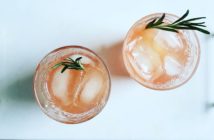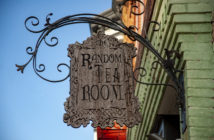note that this article was previously published on December 15th, 2014
One of America’s best-loved chefs, Julia Child was as well known for her culinary skills as for her lively and endearing personality. Determined to make serious cooking accessible and appealing for home cooks, Julia filmed many episodes of her popular television series in her own cheerful kitchen in Cambridge, Massachusetts. As she whisked, chopped and chattered her way through ambitious French recipes, Julia could be seen in her own comfortable space, surrounded by a well-worn collection of tools and ingredients she used regularly throughout her legendary career.
A peek into her actual kitchen, now permanently displayed in the Smithsonian, offers a fascinating glimpse of the legendary cook. As unpretentious as Julia herself, the kitchen is both serious and homey, carefully designed by Julia and her husband Paul to accommodate her 6’2″ frame, her precise culinary requirements and her favorite colors. The counters were raised, the outlines of her saucepans were traced onto pegboard-covered walls to ensure that each was returned to its proper place, and her favorite utensils and ingredients were kept close at hand on counters and shelves.
Describing her tea tins, the Smithsonian wrote:
The butcher block top of the lower cabinet next to the garland- and the cabinet above it-held quite a number of tea tins. A well-used, matched set of them came from Mark T. Wendell, a Boston Tea Company, which Julia and Paul had learned to favor in Ceylon during World War II. They continued to drink these teas over the next 50 years.
What kind of tea did Julia favor? Above the butcher block counter in her kitchen, readily seen in many of the television episodes, were a few of her favorites:
China Keemun
A full-bodied, yet mellow black tea with a lively bouquet. Keemun is renowned as one of China’s finest black teas, superbly crafted with tippy leaves and an aromatic sweetness. When brewed, it produces a dark red cup and makes a great iced tea.
China Jasmine
A lightly fermented pouchong tea, gently touched with freshly picked jasmine blossoms from the Huang Mountain area of China. After repeated exposure to the tea leaves, the flowers are removed, leaving the exotically fragrant aroma behind. China Jasmine makes a sweet and easy drinking brew.
Lapsang Souchong
This rare, long leaf tea gains its distinctive “tarry” flavor and smoky tang from the pine fires over which it is dried. Rich in taste and smoky aroma, it produces a deep red liquor when brewed. China Lapsang Souchong has a smokier taste and aroma than Hu-Kwa Formosan Lapsang Souchong tea.
Cheericup Ceylon
This whole leaf Ceylon is a strong tea with a full, almost brisk flavor. Cheericup Ceylon is a unique blend of seven high and low grown estate teas from the island country of Sri Lanka. When brewed, the bright and sparkling liquor has a sweet and distinct taste that makes for the perfect afternoon tea.
HU-KWA Tea
This long leaf, delicately smoked Lapsang Souchong tea from the island of Formosa has long been a tea connoisseur’s favorite. HU-KWA gains its distinctive flavor and smoky tang from the pine fires over which it is dried, and is considered the benchmark for Chinese Lapsang Souchong tea.
Want to see more of Julia? Check out this toe-tapping remix of some classic Julia Child moments.
Kitchen image by F Deventhal Usage license – CC BY 2.0





